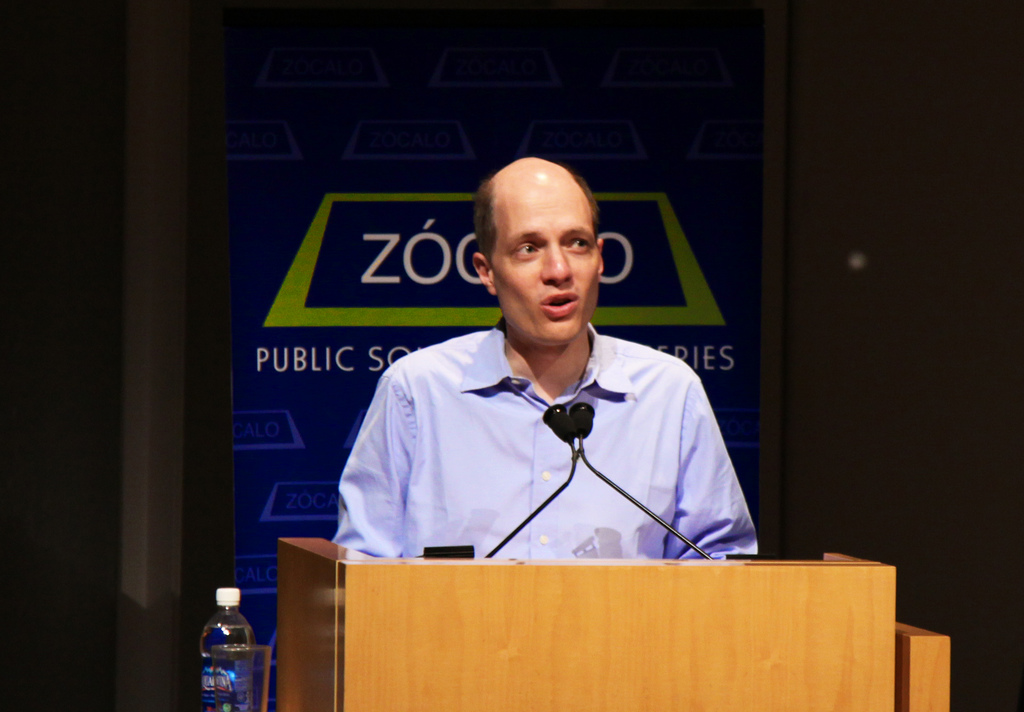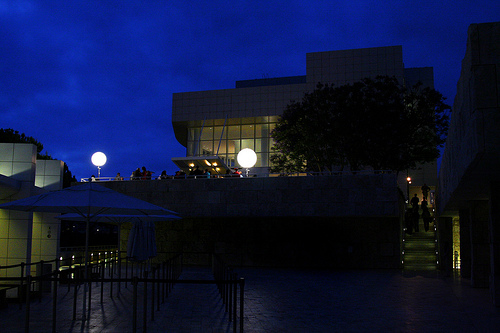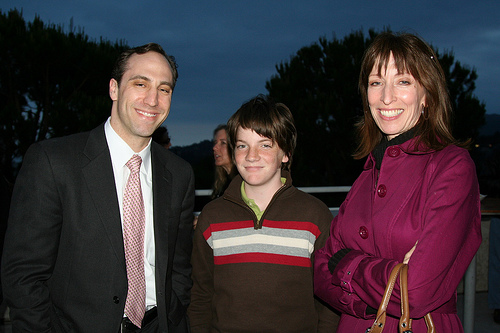
Even Alain de Botton, best-selling author and philosopher of work, has his moments of doubt about his job.
“To be a modern human being means never being far from having a career crisis,” he joked with the crowd at the Getty Museum. “For me, Sunday evening is the favored time for this privileged state. Just as the sun is going down and the gap between what is and what might have been grows.”
De Botton, most recently the author of The Pleasures and Sorrows of Work, explored not only why we worry so much about our jobs, but what we do all day, and how our work came to be so intimately connected with who we are.
Maybe cubicles aren’t so bad
 Historically, de Botton noted, work has had very little to do with identity. It was almost entirely an exercise in brutality. “For most of human history there has been absolutely no expectation that work could be anything other than misery,” de Botton said. Much of the art and photography of work – including some pieces currently on view at the Getty – concerns this view of work, its “deadening” aspect.
Historically, de Botton noted, work has had very little to do with identity. It was almost entirely an exercise in brutality. “For most of human history there has been absolutely no expectation that work could be anything other than misery,” de Botton said. Much of the art and photography of work – including some pieces currently on view at the Getty – concerns this view of work, its “deadening” aspect.
It wasn’t until about 1750 that things began to change, de Botton said, as the first arguments arose for imagining work as a way of asserting identity and becoming fully human. That shift corresponded with a change in attitude toward love: Freud proclaimed love and work the two key ingredients to happiness, and everyone began to believe that marriage was not only an occasion to “pass on the family silver pot or title” but a chance at fulfillment. One possible downside of these changes, de Botton joked, might have been the stigmatization of what he called the “safety valve” of aristocratic culture: the hobby and the mistress. Work and marriage were ideals even though, de Botton said, “probably 60 to 80 percent of us are going to have a problem in one or both of these areas on a fairly regular basis.”
Why write about work
 De Botton began his study of work because he found it missing from most other books, which focused instead on leisure time and culture. “If you were a Martian and you went to any large bookstore, as Martians will,” de Botton said to a laugh, “You’d think human beings spent all their time falling in love, squabbling with their families, and occasionally murdering one another.” He sought to explore careers that aren’t on television and wouldn’t be noticed by, say, tourists taking in the sights. Guidebooks, he said, “almost never tell you what is going on in that factory, what that shed is in the corner, who’s making the money.” Even London ship-spotters, who gather to watch the big boats coming into the harbor, care primarily only about mechanical details rather than the work being done. De Botton compared it to those who have “fallen in love with someone and all they can think of doing is measuring her shoulder blade.” Finally, he said he took inspiration – and considered taking a title – from the children’s book by Richard Scarry called What Do People Do All Day?
De Botton began his study of work because he found it missing from most other books, which focused instead on leisure time and culture. “If you were a Martian and you went to any large bookstore, as Martians will,” de Botton said to a laugh, “You’d think human beings spent all their time falling in love, squabbling with their families, and occasionally murdering one another.” He sought to explore careers that aren’t on television and wouldn’t be noticed by, say, tourists taking in the sights. Guidebooks, he said, “almost never tell you what is going on in that factory, what that shed is in the corner, who’s making the money.” Even London ship-spotters, who gather to watch the big boats coming into the harbor, care primarily only about mechanical details rather than the work being done. De Botton compared it to those who have “fallen in love with someone and all they can think of doing is measuring her shoulder blade.” Finally, he said he took inspiration – and considered taking a title – from the children’s book by Richard Scarry called What Do People Do All Day?
Flying fish
De Botton discussed briefly the various careers he examines in The Pleasures and Sorrows of Work, noting the peculiar qualities of modern working life. “Two hundred years ago we used to know where stuff came from,” he said, explaining why he chose to examine logistics. Now, he said, we have “a feeling of alienation, a loss of a sense of wonder.” While following a forklift operator involved in food distribution, de Botton rekindled such a feeling when he realized the “extraordinary logistical exercise” of getting fish to a dining room table. As de Botton toured a massive food distribution center with a large room covered in tuna fish, a forklift operator told him that the fish were in the Indian Ocean 22 hours prior and would likely be eaten with a day. “Whenever you see a plane flying, it’s probably got fish in the hold,” he said. “It’s a feature of the modern world.”
Jobs about jobs
 De Botton also explored two fields devoted, as he was in writing this book, to the work of work: career counseling and human resources, finding himself in both cases unable to be sarcastic or skeptical about those fields. De Botton initially imagined that HR departments merely practice “the pseudoscience of management,” made necessary because, as he put it, “In the old days all you needed was a whip…. You can’t really hit anybody these days.” But HR, he said, seems essential to our age of gigantic organizations with high ambitions and high standards of performance, which seem simultaneously to result in much time wasted and much workaholism. In one office he visited, HR had established a 24-hour anti-bullying hotline, among other innovations. Because of these measures, whereas home life was once associated with kindness and sensitivity and work life was all exploitation, de Botton joked, “In the most advanced organizations it’s almost like that equation has been reversed.”
De Botton also explored two fields devoted, as he was in writing this book, to the work of work: career counseling and human resources, finding himself in both cases unable to be sarcastic or skeptical about those fields. De Botton initially imagined that HR departments merely practice “the pseudoscience of management,” made necessary because, as he put it, “In the old days all you needed was a whip…. You can’t really hit anybody these days.” But HR, he said, seems essential to our age of gigantic organizations with high ambitions and high standards of performance, which seem simultaneously to result in much time wasted and much workaholism. In one office he visited, HR had established a 24-hour anti-bullying hotline, among other innovations. Because of these measures, whereas home life was once associated with kindness and sensitivity and work life was all exploitation, de Botton joked, “In the most advanced organizations it’s almost like that equation has been reversed.”
And for those who don’t like the cubicle life, there’s the career counselor. Studying the trade, de Botton witnessed the method of encouraging a counselee to think and write about the simple question, “What do you like,” and about what they wanted to do as children. “Children on the whole never ask themselves what they want to do next,” de Botton said to a laugh. “Should I play with Legos? Might it be better to draw? As adults we’ve somehow, somewhere along the way, lost our intuition.” That’s due, he suggested, to our search for status and our need for financial stability. Watching people reflect on what they wanted to do as children, and what “many little things might have totally put them off course,” left de Botton moved. “It’s very hard to pin us down to our jobs. Maybe none of us or very few of us really end up in the job that we merit,” he said, citing St. Augustine’s belief that it was a sin to judge anybody by their post.
Thank goodness for biscuits, and the Sabbath
 A biscuit (“what you call cookies,” the London resident clarified) factory visit gave de Botton occasion to ponder the intrinsic value of work. The process of getting the biscuit to a store shelf, he found, involved hundreds of highly specialized people specifically targeting a product. “Way before you know what biscuit you want,” de Botton said to a laugh, “the biscuit knows you’re coming.” Specialization is key to wealth in the modern world, and even keeps the poorest of the poor from starvation, according to Adam Smith, as de Botton noted in Q&A.
A biscuit (“what you call cookies,” the London resident clarified) factory visit gave de Botton occasion to ponder the intrinsic value of work. The process of getting the biscuit to a store shelf, he found, involved hundreds of highly specialized people specifically targeting a product. “Way before you know what biscuit you want,” de Botton said to a laugh, “the biscuit knows you’re coming.” Specialization is key to wealth in the modern world, and even keeps the poorest of the poor from starvation, according to Adam Smith, as de Botton noted in Q&A.
That didn’t mean the biscuit factory workers weren’t, he said, puzzled and frustrated with the meaning of their work. (And everyone, de Botton noted in Q&A, thinks about his work rather than simply muddles through, even if we don’t think about work carefully enough.) De Botton argued that any job that helps others is meaningful, including along with doctors and nurses, those “uniting people with their lost luggage.” “If you’ve ever been hungry at 11 o’clock in the morning and you reach for the biscuit jar, well, thank goodness biscuits exist,” he said. Unfortunately, he noted, workers in large corporations like the biscuit factory are often too divorced from the impact of their work.
However, there are other pleasures of work, and not simply that the office can be a “remarkably erotic place.” Work “keeps us distracted,” he said, serving as “a haven into which we escape from problems that are too large for us.” Work helps us create something a “little bit better than we are.” And the social implications are just as worthwhile. Understanding what an “unbelievable amount of labor” goes into everything moved de Botton.
And even the day off has some significance. From a secular perspective, de Botton argued, Sabbath could be considered as a check on megalomania and workaholism. “You did not create the world,” de Botton said. “So put down your tools and acknowledge that though you control some of the levers of the world, you don’t control them all.”
Watch the video here.
See more photos here.
Buy the book here.
*Photos by Aaron Salcido.




Send A Letter To the Editors